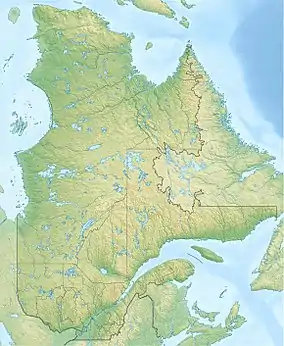| Huron River | |
|---|---|
 | |
| Native name | Rivière Huron (French) |
| Location | |
| Country | Canada |
| Province | Quebec |
| Region | Centre-du-Québec |
| MRC | L'Érable Regional County Municipality, Bécancour Regional County Municipality |
| Physical characteristics | |
| Source | Agricultural and forest streams |
| • location | Laurier-Station and Notre-Dame-du-Sacré-Cœur-d'Issoudun |
| • coordinates | 46°33′03″N 71°38′46″W / 46.550756°N 71.646214°W |
| • elevation | 90 metres (300 ft) |
| Mouth | Rivière du Chêne |
• location | Leclercville (sector of Sainte-Emmélie) |
• coordinates | 46°30′16″N 71°47′12″W / 46.50444°N 71.78667°W |
• elevation | 60 metres (200 ft) |
| Length | 20.6 kilometres (12.8 mi) |
| Basin features | |
| River system | St. Lawrence River |
| Tributaries | |
| • left | (upstream) rivière aux Ormes, cours d'eau de la Grande Ligne Seigneuriale, Tête de la Rivière Huron |
| • right | (upstream) Noire River, ruisseau Le Rigolet, ruisseau Lambert, ruisseau Bois Franc-Pierreriche |
The Huron River (in French: rivière Huron) is a tributary of the east bank of the rivière du Chêne which empties on the south shore of the St. Lawrence River. The Huron River flows through the municipalities of Laurier-Station, Notre-Dame-du-Sacré-Cœur-d'Issoudun, Saint-Édouard-de-Lotbinière, Saint-Janvier-de-Joly and Leclercville, in the Lotbinière Regional County Municipality, in the administrative region of Chaudière-Appalaches, in Quebec, in Canada.
Geography
The main neighboring watersheds of the Huron River are:
- north side: Boucher arm, rivière du Bois Clair, Petit Saut river, Noire River, St. Lawrence River;
- east side: Bois Franc-Pierreriche stream, Bourret stream, Rouge River (Beaurivage River tributary), rivière aux Pins (Beaurivage River tributary), Beaurivage River;
- south side: Rivière aux Ormes (Huron River tributary), Rivière aux Cèdres, Rivière du Chêne;
- west side: rivière du Chêne.
The Huron River has its source at the confluence of the "Head of the Huron River" stream and a stream draining the northern part of the village of Laurier-Station. The "Tête de la Rivière Huron" flows on 7.6 kilometres (4.7 mi) east to the intermunicipal limit of Laurier-Station and Notre-Dame-du-Sacré-Cœur-d'Issoudun; this stream drains the northern part of Saint-Flavien and the eastern and southern area of Laurier-Station.
From its source, the Huron River flows over 20.6 kilometres (12.8 mi) with a drop of 30 metres (98 ft), divided into the following segments:
- 1.2 kilometres (0.75 mi) northwesterly, then northeasterly, crossing route 271, to the confluence of the Bois Franc-Pierriche stream;
- 2.6 kilometres (1.6 mi) north-west, up to route 271;
- 3.7 kilometres (2.3 mi) westward, up to the limit of Saint-Janvier-de-Joly;
- 3.0 kilometres (1.9 mi) towards the south-west, marking the limit of Saint-Janvier-de-Joly and Notre-Dame-du-Sacré-Cœur-d'Issoudun, to the intermunicipal limit of Saint-Édouard-de-Lotbinière;
- 8.9 kilometres (5.5 mi) (or 5.0 kilometres (3.1 mi) in a direct line) towards the southwest, winding up to the limit of Leclercville;
- 1.2 kilometres (0.75 mi) towards the west, in Leclercville until its confluence.[1]
The Huron River empties on the east bank of the rivière du Chêne in the Lucieville Range, in Leclercville.
Toponymy
The toponym Rivière Huron was formalized on December 5, 1968, at the Commission de toponymie du Québec.[2]